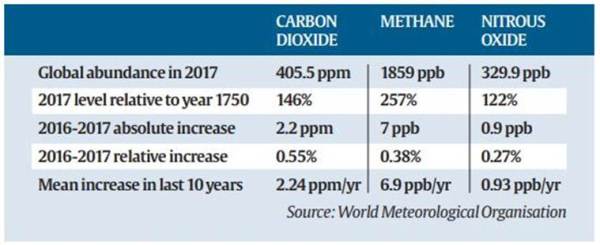Context:
- The amounts of greenhouse gases in the atmosphere have hit yet another record high, the World Meteorological Organisation (WMO) said in its latest Greenhouse Gas Bulletin.
- The WMO is the weather agency of the United Nations, and publishes its Greenhouse Gas Bulletin each year; this year’s report covers data for 2017.
- In a statement, the WMO said that there is no sign of a reversal in the trend of rising levels of greenhouse gases in the atmosphere, which is driving long-term climate change, sea level rise, ocean acidification and more extreme weather.
- “The science is clear. Without rapid cuts in carbon dioxide and other greenhouse gases, climate change will have increasingly destructive and irreversible impacts on life on Earth.
- The window of opportunity for action is almost closed,” WMO Secretary-General Petteri Taalas said in the statement.
- The last time the Earth experienced a comparable concentration of carbon dioxide was 3-5 million years ago, when the temperature was 2-3°C warmer and sea level was 10-20 metres higher than now.
Findings
Carbon dioxide:
- Concentrations of the gas reached 405.5 parts per million in 2017, 146% of the pre-industrial era (before 1750). The increase in carbon dioxide from 2016 to 2017 was about the same as the average growth rate over the last decade. It was smaller than the record leap observed from 2015 to 2016 (from 401.1 ppm to 403.3 ppm) under the influence of a strong El Niño event; there was no El Niño in 2017.
Methane:
- Atmospheric methane reached a new high of about 1859 parts per billion in 2017 and is now 257% of the pre-industrial level. Its rate of increase was about equal that observed over the past decade.
Nitrous Oxide:
- Its atmospheric concentration in 2017 was 329.9 parts per billion. This is 122% of pre-industrial levels.

CFC-11:
- The GrrenHouse Gas Bulletin has a special section devoted to CFC-11 (trichlorofluoromethane).
- This is a potent greenhouse gas and a stratospheric ozone depleting substance regulated under the Montreal Protocol. Since 2012, its rate of decline has slowed to roughly two-thirds of its rate of decline during the preceding decade.
- The most likely cause of this slowing is increased emissions associated with production of CFC-11 in eastern Asia, the bulletin says.
Source:IE
